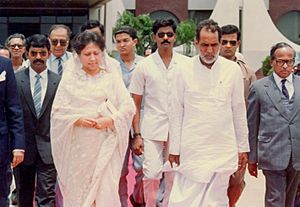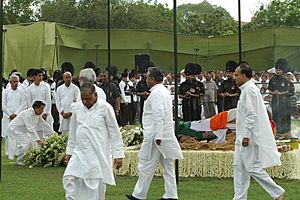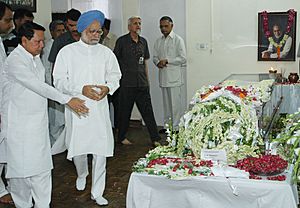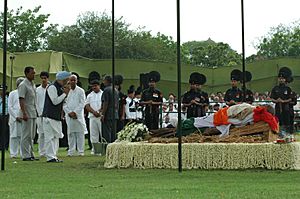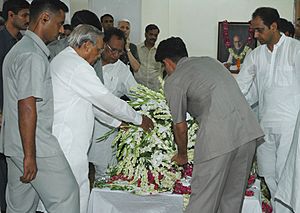Chandra Shekhar facts for kids
Quick facts for kids
Chandra Shekhar
|
|
|---|---|
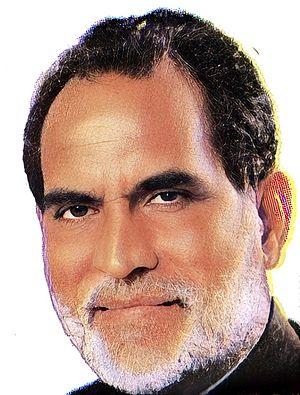 |
|
| 8th Prime Minister of India | |
| In office 10 November 1990 – 21 June 1991 |
|
| President | R. Venkataraman |
| Deputy | Chaudhary Devi Lal |
| Preceded by | V. P. Singh |
| Succeeded by | P. V. Narasimha Rao |
| President of the Janata Party | |
| In office 1977–1988 |
|
| Preceded by | Position established |
| Succeeded by | Ajit Singh |
| Member of Parliament, Lok Sabha | |
| In office 1989–2007 |
|
| Preceded by | Jagannath Chowdhary |
| Succeeded by | Neeraj Shekhar |
| Constituency | Ballia |
| In office 1977–1984 |
|
| Preceded by | Chandrika Prasad |
| Succeeded by | Jagannath Chowdhary |
| Constituency | Ballia |
| Member of Parliament, Rajya Sabha | |
| In office 1962–1977 |
|
| Personal details | |
| Born | 17 April 1927 Ibrahimpatti, United Provinces, British India (present-day Uttar Pradesh, India) |
| Died | 8 July 2007 (aged 80) New Delhi, India |
| Political party | Samajwadi Janata Party (Rashtriya) (1990 – 2007) |
| Other political affiliations |
|
| Spouse | Duja Devi |
| Children | 2 (including Neeraj Shekhar and Yogendra Singh) |
| Alma mater | Allahabad University |
| Signature |  |
Chandra Shekhar (born 17 April 1927 – died 8 July 2007) was an important Indian politician. He served as the 8th Prime Minister of India from 10 November 1990 to 21 June 1991. He led a government that had fewer members of parliament (MPs) from his own party. He received support from the Indian National Congress to form his government.
Chandra Shekhar was the first Prime Minister of India who had not held a government job before becoming Prime Minister. His time as Prime Minister was short, lasting only seven months. During this period, India faced big economic challenges. His government also allowed US military planes to refuel in India during the Gulf War. This decision helped improve India's relationship with Western countries.
Contents
About Chandra Shekhar
Early Life and Education
Chandra Shekhar was born on 17 April 1927 in a village called Ibrahimpatti in Uttar Pradesh, India. He came from a farming family. He earned a Bachelor of Arts degree from Satish Chandra P.G. College. Later, he studied at Allahabad University and received his master's degree in political science in 1950. He was very active in student politics and began his political journey with Dr. Ram Manohar Lohia.
Family Life
Chandra Shekhar married Duja Devi. They had two sons together, Pankaj Shekhar Singh and Neeraj Shekhar.
Political Journey
Starting His Career
Chandra Shekhar joined the socialist movement early in his career. He became the secretary of the Praja Socialist Party (PSP) in his district, Ballia. Soon after, he was elected as the joint secretary for the PSP in Uttar Pradesh. From 1962 to 1977, he was a member of the Rajya Sabha, which is the upper house of India's Parliament.
He was first elected to the Rajya Sabha in 1962 as an independent candidate. Later, he was re-elected twice as a candidate for the Indian National Congress. In 1977, he was elected to the Lok Sabha (the lower house of Parliament) from Ballia. During a difficult time known as the Emergency, he was arrested and sent to jail, even though he was a member of the ruling Congress party.
Joining the Congress Party
Chandra Shekhar was a well-known leader among socialists. He joined the Indian National Congress in 1964. He was known as a 'young Turk' because he was brave and spoke out against powerful groups. Other 'young Turks' included leaders like Feroze Gandhi and Mohan Dharia. As a Congress member, he strongly criticized Prime Minister Indira Gandhi when she declared the Emergency in 1975.
The Bharat Yatra (1983)
In 1983, Chandra Shekhar went on a long walk across India called a padayatra. He walked from Kanyakumari in the south to New Delhi in the north. He walked about 4,260 kilometers (2,647 miles) over nearly six months. He said he did this to understand the country better.
He started his walk on 6 January 1983. He finished it on 25 June, which was the eighth anniversary of the Emergency. Chandra Shekhar also set up Bharat Yatra Centres in different parts of the country. He created a trust in Bhondsi village in Haryana to help with rural development.
In the Janata Party
After being released from jail during the Emergency, Chandra Shekhar became the President of the Janata Party. This party formed the government after the 1977 elections, led by Morarji Desai. However, the Janata Party lost the elections in 1980 and 1984. Chandra Shekhar even lost his own seat in Ballia in 1984.
In 1988, he resigned from his post as Janata Party President. His party then merged with other parties to form a new government under V. P. Singh. However, Chandra Shekhar's relationship with this new coalition government became difficult. He then formed his own party, the Samajwadi Janata Party (Rashtriya). With support from Rajiv Gandhi and the Congress (I) party, he became the Prime Minister of India in November 1990.
Becoming Prime Minister
Chandra Shekhar left the Janata Dal party with his supporters to form the Samajwadi Janata Party (Rashtriya). He gained the support of Rajiv Gandhi, who was the leader of the opposition. With this support, he became the Prime Minister. Eight members of parliament who voted for him were later disqualified.
Serving in Parliament
Chandra Shekhar was a member of the Rajya Sabha from 1962 to 1977. He was jailed during the Emergency. After his release in 1977, he joined the Janata Party. He was elected to the Lok Sabha from Ballia (Lok Sabha constituency) many times: in 1977, 1980, 1989, 1991, 1996, 1998, 1999, and 2004. He only lost this seat once, in the 1984 election. After he passed away, his son Neeraj Shekhar won the election for the same seat in 2008.
Other Government Roles
Minister of Information and Broadcasting (1990-1991)
While he was Prime Minister, Chandra Shekhar also served as the Minister of Information and Broadcasting. He held this position from 21 November 1990 to 21 June 1991. He was followed in this role by P. V. Narasimha Rao.
Minister of Home Affairs (1990-1991)
Chandra Shekhar also managed the role of Minister of Home Affairs for seven months. He was the Prime Minister at the same time. Before him, Mufti Mohammad Sayeed held this position, and after him, Shankarrao Chavan took over.
Minister of Defence (1990-1991)
In addition to other ministries, Chandra Shekhar also handled the Ministry of Defence while he was Prime Minister. He was the Defence Minister for a short period of seven months. V. P. Singh was the Defence Minister before him, and P. V. Narasimha Rao took over after him.
As Prime Minister
Chandra Shekhar served as Prime Minister for seven months. This was one of the shortest terms for an Indian Prime Minister. He also held the important jobs of Defence Minister and Home Affairs Minister during this time. His government faced a big challenge when the Congress party withdrew its support in March 1991. Because of this, his government could not pass a full budget. Chandra Shekhar resigned as Prime Minister on 21 June 1991.
Manmohan Singh was his economic advisor. They worked on ideas for economic changes, but these could not be passed in Parliament.
After Being Prime Minister
After his time as Prime Minister, Chandra Shekhar's political influence became less. However, he continued to be elected to his seat in the Lok Sabha for many more years.
Passing Away
Chandra Shekhar passed away on 8 July 2007. He had been unwell for some time and was in Apollo Hospital in New Delhi since May. He was survived by his two sons.
Many politicians from different parties in India paid their respects to him. The Indian government declared seven days of national mourning. He was cremated with full state honors on 10 July at Jannayak Sthal, near the Yamuna river. In August, his ashes were placed in the Siruvani river.
See also
 In Spanish: Chandra Shekhar para niños
In Spanish: Chandra Shekhar para niños
- Pradhanmantri Sangrahalaya


